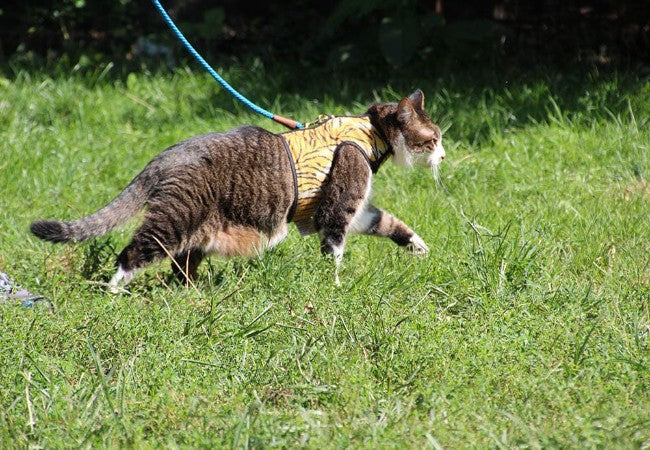Should I Walk My Cat in 2025? Vet Tips on Harness Training, Safety & Enrichment🐾

In this article
Should I Walk My Cat in 2025? Vet Tips on Harness Training, Safety & Enrichment🐾
By Dr. Duncan Houston BVSc
✅ Yes, You Should Walk Your Cat—Here’s Why
While it may seem unusual, walking your cat outdoors on a leash or in a pram can offer incredible enrichment, exercise, and confidence-building—especially for indoor cats. Done right, it can improve physical health and reduce stress, boredom, and even behavioral issues 🐈✨.
📈 Benefits of Walking Your Cat
- 🧠 Mental stimulation: New smells, sights, and sounds enrich their senses
- 🏃♂️ Physical activity: Supports weight control, agility, and heart health
- 😺 Behavior improvement: Reduces indoor stress behaviors (e.g., aggression, overgrooming)
- 🧘 Confidence boost: Helps shy cats build bravery in safe outdoor experiences
🛒 What You’ll Need
- 🪢 Cat harness: Secure, escape-proof designs like H-style or vest-style
- 🦮 Leash: Lightweight and short (4–6 feet) to maintain gentle control
- 🛒 Cat pram or stroller: Great for nervous cats or urban walks
- 🍖 High-value treats: Liquid tube treats (Inaba Churu), Ziwi Peak cat food, or freeze-dried rewards
- 👜 Portable carrier: Backup safety in case of stress or emergency
🧭 Step-by-Step: How to Start Walking Your Cat
- 1. Introduce the harness indoors: Let them sniff it, then wear it for short periods with rewards.
- 2. Attach the leash inside: Let your cat drag it gently while roaming freely. Offer praise and treats.
- 3. Begin lead guidance indoors: Gently encourage walking beside you, using treats to lure and reward.
- 4. First outdoor exposure: Choose a quiet, enclosed garden or courtyard. Keep sessions short and positive.
- 5. Graduate to short walks: Explore quiet laneways, parks, or quiet streets at off-peak hours.
- 6. Pram training (optional): Start with familiar blankets and treats inside, then push gently indoors before taking it outside.
🧘 Tips for Success
- ⏳ Go slow: Some cats take weeks or months to feel confident—respect their pace
- 🍗 Use food motivation: Churu, Ziwi, or lickables work wonders for reward and distraction
- 🔇 Quiet environments first: Avoid dogs, cars, and crowds early on
- 😻 Watch body language: Flattened ears, puffed tail, or crouching means stop and retreat
- 📦 Always bring a carrier or pram: Safety backup if your cat panics or a threat arises
⛔ What to Avoid
- 🚫 Forcing your cat outside if they resist or show fear
- 🚫 Using a dog collar (unsafe and easily escaped)
- 🚫 Letting them roam freely or off-leash
- 🚫 Walking in dog-heavy or noisy environments too early
🧸 How Ask A Vet,
- 🩺 Ask A Vet: Ask about safety, training, and behavior tips tailored to your cat’s age and breed
📅 Weekly Training Plan
| Day | Goal | Duration |
|---|---|---|
| Monday | Try harness indoors | 5 minutes |
| Tuesday | Attach leash indoors | 10 minutes |
| Wednesday | Practice follow with treats | 10 minutes |
| Thursday | Visit patio or balcony | 5 minutes |
| Friday | Short garden walk or pram ride | 5–10 minutes |
| Saturday | Explore quiet sidewalk | 10–15 minutes |
| Sunday | Rest day or repeat favorite session | Varies |
🎯 Final Thoughts
Yes—you should walk your cat if they enjoy it. Done gently, it’s enriching, healthy, and can even help anxious or overweight cats. With patience, treats, and safe gear, many felines grow to love exploring the world beside you 🐾.
And remember—just like training a dog, consistency and calm encouragement make all the difference.
— Dr Duncan Houston, BVSc
Not sure where to begin? Visit AskAVet.com or download the Ask A Vet app for 24/7 advice on feline enrichment and behavior coaching.






